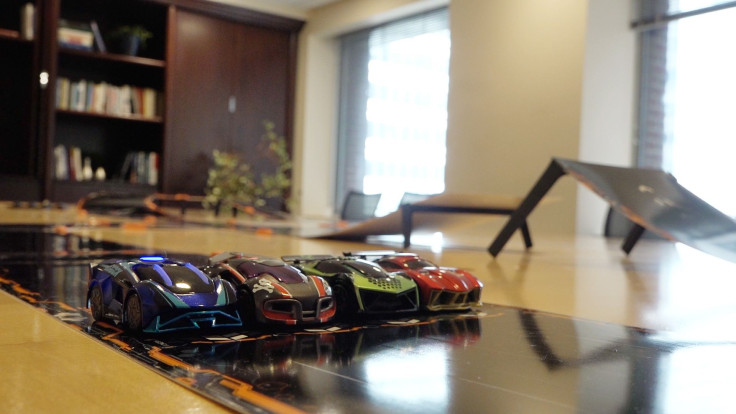Anki Overdrive Review: Robot Cars Controlled By iPhones Can Replace Slot Cars [VIDEO]

When it comes to toys, slot car tracks are traditionally known as brittle, cumbersome objects that will be stepped on or destroyed before the day is done. But what if you could get an easily modified, easily built track that uses your phone or tablet as a controller? You would have Anki Overdrive, a new racing game from Anki, a toy and game company in San Francisco.
At its most basic level, Anki Overdrive is a set of slot cars driven by smartphones. There are no physical “slots” for the cars to go in, however the track is four lanes wide, with no barriers separating them. To avoid mass catastrophe, the cars take a test lap of the track you’ve built, so they know exactly where all the twists and turns are. There are sensors in both the cars and the track pieces, so all you have to do is control the throttle from your device. Add to that a small arsenal of powerups and weapons, and the Overdrive cars are a little closer to the Mario Kart video game than a Tyco toy.
The cars operate mostly on autopilot, sticking to the course with tiny magnets. However, things can and will get messy on track if you’ve not paid enough attention. You have to be a bit careful when setting up more complicated routes, particularly involving jumps. If you don’t brace the track pieces just right, the cars are liable to misjudge distances. That usually results in one or more of the cars falling off the track, or inexplicably turning around -- like your sore-loser cousin who’s mad abut being last on Rainbow Road and would rather ruin your race than learn to play better.
Luckily, just about anyone with a smart device will be able to join: Overdrive works with both Apple iOS and Google Android devices. What you basically get, once you’ve connected to your chosen car over Bluetooth, is a very straightforward control panel with toggles for powerups, weapons, and throttle. To change “lanes,” just tilt your device left or right, and the car will move over. You’re hard-pressed to really crash on your own no matter how fast you go, though other players’ weapons may shove you off the track. It’s a clever system that takes a lot of the guesswork out of slot cars, especially for the younger players [though how challenging the tracks can be is entirely up to your imagination].
Track design and customization is sensible, as well. Pieces snap together and come apart easily, letting you change configurations in a minute or two. Put in a jump if you want, or have the track cross over itself; you don’t even have to buy separate tracks to change designs.
Anki charges $150 for the Overdrive kit, which comes with a plethora of track pieces and four cars. That might seem like a lot, considering you can get the toy-grade traditional slot car tracks in this scale for anywhere from $40 to $100, but the ease of use, customization, and setup may be enough to justify the price tag.
© Copyright IBTimes 2025. All rights reserved.




















